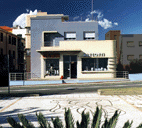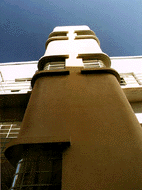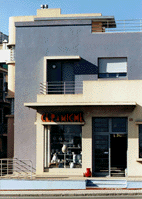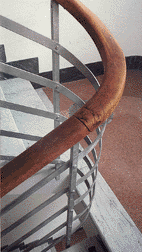Casa Mazzotti
Albisola Marina (Sv)
Commissioned by Tullio d'Albisola as his own house-cum-workshop-cum-showroom, it was designed by Futurist Architect Nicolaj Diulgheroff from 1930, while the construction was completed in 1934.
Casa Mazzotti is the only example of futurist dwelling remained intact until today: it was entirely designed and built under the direction of the designer and over the years the building has not undergone any changes or additions. It currently hosts the Ceramiche Mazzotti firm and Tullio d'Albisola's document archive.
Exterior Volumes
The house, with its colorful geometric volumes, assembled according to the different functions, is a rare example of futurist architecture. Many details designate such a dynamic style: the projecting roofs at the entrance of the showroom and in the residence facade, the large windows of the house and the curved ones in the stairwell, the many metal railings, the harmonious light and shadow effects, the curved parts of the staircase and of the showroom, the overhangs framing the openings and the rounded corners. The proportion and division of volumes according to their functions is instead rationalist: house, ceramics workshop and showroom for display and sale.
Architectural Last Will
and Testament
«Architecture is beautiful and superior to other arts, because it creates living and harmonious organisms...The design of the new Ceramiche Mazzotti Pottery has a modern and futurist style, but a futurism we do not have to fear much because “we are very, very far from Prampolinian Futurism”. In our project there is nothing but "simplicity, logic, proportion, economy," the rest is harmony and good taste.»
These are the words that Diulgheroff wrote to his friend Tullio on December 16, 1930. The architectural ideal theory expressed here has become his will, there being very few examples of futurist architecture that have reached our days. The proximity to the beach inspired the architect in the choice of colors, and so he wrote on July 26, 1932:
«I have chosen three tones: pale yellow (almost white) for the forepart of the showroom to stand out well from the blue-grey three-dimensional complex of the dwelling house, while the staircase tower, stuck in the middle block, is all painted in yellow earth or vice versa.»
The suggested colors were then created by Tullio and still today they stand out as unusual in the Ligurian seafront.
Internal Partitions
Only the inside of the dwelling has been modified to fit the current housing needs, while the showroom and the stairwell have been maintained in the original aspect, as regards both the marble chips flooring design and the furnishings; the showroom shelves and displays were designed by Diulgheroff and the original grey colour of the ledges has been maintained. The showroom houses the artifacts of the Ceramiche Mazzotti firm which continues the production of ceramics and artistic majolicas of exquisite charm and accurate processing, respecting Albissola's artisanal tradition.
The Continuity of Tradition
Tullio d'Albisola's house has been restored several times and is still a house-cum-workshop-cum-showroom as in the past and, however peculiar, is lived with intensity and pride by Tullio's heirs, who have managed to privately preserve this undoubtedly unique and singular cultural and historic heritage, through the memory of the dear ones.
The Architect Nicolaj Diulgheroff
He was born in Kyustendil, Bulgaria on December 20, 1901. He attended the Kunstgewerbeschule in Vienna and the Neue Schule Fur Kunst der Weg in Dresden.
In 1903 he stayed at the Bauhaus in Weimar and in 1926 he moved to Italy, where he finished his studies at the Superior School of Architecture of the Albertina Academy in Turin and graduated in 1932. Meanwhile he participated as a painter in group and solo exhibitions, he drew furniture, lamps, ceramic and crystal objects.
In Turin itself he began his participation in the Futurist Movement, where he exposed at the First Exhibition of Futurist Architecture and later in many other cities, including Mantua, Milan, Alessandria, Venice, Rome, Paris.
In 1931-32 he worked on Casa Mazzotti in Albissola Marina. He designed and manufactured numerous pieces of furniture as well as ceramics for the Mazzotti family in Albissola. His intense artistic and architectural activity continued until his death in Turin, where he had always lived.
Pictures by Fabio Fidone ©
CLICK TO ZOOM THE IMAGES

Casa Mazzotti:Futurist Architecture
Mosaic flooring realised according to Tullio d'Albisola's design.

Overhanging projecting roof of the dwelling.

The curved volumes of the stairwell.

The entrance of the showroom, on the first floor the dwelling.

Internal staircase balustrade.

The showroom shelves realised according to Diulgheroff's original design.
Giuseppe "Bausin" Mazzotti with Nicolaj Diulgheroff in front of Casa Mazzotti.